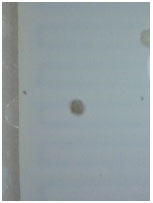Foreign Material on White Polyimide
 It's probably adhesive. Is it OK to leave it?
It's probably adhesive. Is it OK to leave it?
I have an LED application where I need my flex to have white solder mask or white polyimide. When I received my first prototypes, there seemed to be a lot of small specks of “stuff” on the outer surface. I have used flex circuits in the past, but they all used amber polyimide covers. I never noticed these specks before. Is there something different in processing white polyimide that would cause these spots?
Answer: I recently stopped at the drive-through of a local fast food restaurant and grabbed a sandwich, which I then attempted to eat as I drove. As I chomped into one side of the sandwich, BBQ sauce squirted out the other side and landed all over my jeans. After chastising myself for trying to eat something that messy without a table between the food and my pants, I pulled over and wiped up the mess. I was pleasantly surprised to see the spots on my dark jeans were barely noticeable. I can guarantee if I had been wearing white pants, those BBQ sauce spots would have stood out like a sore thumb.
I am pretty sure the same thing is happening with your flexible circuits. The small specks you are seeing on the white polyimide were probably also on the amber polyimide. You just didn’t see them because they were small and situated on a relatively dark background.
Do not expect all flexible circuits to be covered with foreign material, of course. On the contrary, the vast majority should be very clean and free of surface debris. IPC-6013 addresses this issue in paragraph 3.3.10, Workmanship:

Remember, “visual evidence” is only the stuff visible at 1.75x! While foreign material on the polyimide cover is not the norm, it is also not uncommon for there to be an occasional speck or two of “stuff” on the outer surface.
What is this “stuff,” you ask? The most common debris seen on the outer surface is adhesive. Drilling, routing and sometimes punching processes used on polyimide cover material can create particulate that can be deposited on the polyimide surface. These particles are made of polyimide, adhesive (epoxy or acrylic), and occasionally the drill entry or backup material. Spindle vacuums on CNC driller/routers suck up the majority of all debris, but sometimes a small amount of debris is left behind.
The drilled/routed/punched covers are usually cleaned before they are applied to the flex circuits to remove the lion’s share of any remaining debris. But again, these cover cleaning operations (usually tacky rollers or blowers) are not perfect systems, and some small amount of debris may remain when the circuits are placed in the press to laminate the covers.
The good news is polyimide and drill entry/drill back material debris usually will not permanently bond to the outer polyimide surface and will generally come off during subsequent wet processing (e.g., final finish). Adhesive debris, on the other hand, bonds to the surface very well, and wet processing will not remove it. Also, press lamination temps will slightly darken these translucent adhesive specks, which will make them blend in even more on amber covers and stand out more on white covers (FIGURE 1). More than likely, what you are seeing on the white covers on the flex are small adhesive flecks that darkened during cover lamination. This is basically a cosmetic issue, and should not cause any form, fit or function issues in the application. Adhesive residue bonded to the polyimide surface is not conductive and should not have any effect on the flexibility of the circuit, as long as it is limited to just a few small specks.

Figure 1. Adhesive specks on white polyimide following lamination.
Still concerned? Answer these two questions:
- Is the particulate translucent? If so, you should be OK, because translucent material is generally considered nonconductive.
- Can you remove the particulate with alcohol on a cotton swab?
- If the flecks do come off, you may be seeing flux residue from a soldering operation. This would not be acceptable and should be addressed with the vendor.
- If the spots do not come off, you have something nonconductive (per the first bullet point above) that is relatively well adhered to the surface and should not come off at a later time.
If you still have concerns, a call to your supplier may be in order. If your requirements for cleanliness exceed what is outlined in IPC-6013D, you can probably expect it will have some level of cost impact.
is senior application engineer at Flexible Circuit Technologies (flexiblecircuit.com); This email address is being protected from spambots. You need JavaScript enabled to view it.. He and co-“Flexpert” (This email address is being protected from spambots. You need JavaScript enabled to view it.) welcome your suggestions. The authors will speak on flex design and manufacture at PCB West in September (pcbwest.com).




